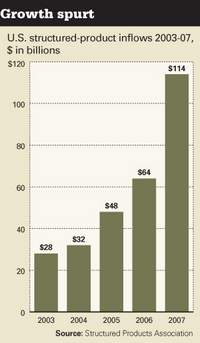By Timothy Andrews, Scotia Capital
Special to Euromoney, Published April 2008
The structured fund derivatives landscape has evolved substantially in recent years with an estimated current notional size of over US$700bn globally. An increasing number of treasurers, portfolio managers and other investors are seeking increased returns through exposure to alternative assets via a variety of fund-linked derivatives products. Common fund-linked derivatives products include various options, total return swaps, portable alpha strategies and structured notes. These products can be linked to single hedge funds, fund of funds, fund indices or a basket of the same (each a ‘reference fund asset’).
1. Black-Scholes call options
In the basic form of a ‘plain vanilla’ or ‘black-scholes’ call option referencing a reference fund asset, an investor purchases an over-the-counter call option by paying a premium amount to the financial institution (the ‘bank’) on the trade date. The strike price of the call option is typically fixed either ‘at’ or ‘out of the money’ at inception. The call option is structured to be ‘European style’ which means the investor can exercise the option only at maturity. The cash settlement amount, if any, owed by the bank to the investor at maturity is equal to the amount by which the net asset value of the reference fund asset exceeds the strike price of the call option. In some cases, the call option may also be physically settled where the investor would pay the strike price to the bank and receive physical delivery of the reference fund asset. To the extent that the net asset value of the reference fund asset was less than the strike price, the option would expire worthless and the investor would lose the premium paid at inception.
2. Accreting strike call option structures
The accreting strike call option (‘ASCO’) is among the most widely used fund-linked derivatives today. Take the example of an investment manager looking to launch a leveraged fund (the ‘leveraged fund’) to raise additional capital. Assume the leveraged fund offers investors US$3 of exposure to the underlying reference fund assets for every US$1 invested, or ‘three times’ leverage. Suppose the leveraged fund has US$100m in new subscriptions.
Under an ASCO structure, the leveraged fund would purchase a cash settled over-the-counter call option from the bank for premium amount equal to the US$100m in subscription monies and receive a notional exposure to a basket of reference fund assets equal to US$300m, equating to three times leverage. The bank would most likely hedge its position on a ‘delta one’ basis by purchasing US$300m of the reference fund assets, but could also hedge via another derivative.
For Tim Andrews' full article on the structured fund landscape, click here.
Subscribe to:
Post Comments (Atom)




No comments:
Post a Comment